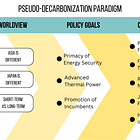A few days ago, Prime Minister Kishida gave his policy speech to both houses of the Diet (here are the video and text of Kishida’s speech, both in Japanese).
Like a State of the Union address in the United States, the prime minister’s policy speech is an annual norm where he (always a “he” so far) explains his government’s overall policy objectives and direction.
As such, the 45-minute speech gave a good glimpse into how he and his government are thinking about the current political developments, both in and beyond Japan. It also gave clues as to where Kishida thinks the energy transition fits into his broader policy priorities.
In this post, I want to give a quick summary of his speech and where Japan’s GX policy stands.
Long story short, the GX policy is touched on as only a relatively minor branch of economic policy. This might confirm my view that it’s driven by a “pseudo-decarbonization paradigm.” It might also be that there are other more pressing issues for Kishida and the Liberal Democratic Party. The truth is probably a combination of these things.
Noto Earthquake
Appropriately enough, Kishida began his speech with a long discussion of the earthquake that struck the Noto Peninsula on January 1. Sending his thoughts and prayers to the people who were affected (and are still living in shelters), he also expressed his deep gratitude to emergency responders who helped survivors amidst poor weather and aftershocks.
Through it all, he commended the “power of bonds” among the Japanese people that was on display during the disaster relief.
Regaining trust after the political funds scandal
“Policy can’t be promoted without political stability. And without citizens’ trust, there is no political stability.” These were Kishida’s words around 9 and a half minutes into his speech.
Of course, what he is referring to is the political funds scandal that has embroiled the LDP since November last year.
For those of you wanting to deeper into what this scandal means for LDP factions, Tobias Harris at Observing Japan offers an expert analysis:
After offering an apology for the scandal, he vowed to push through reforms to strengthen transparency of political fundraising.
Economy, economy, economy
Most of Kishida’s speech was about the state of Japan’s economy and the economic policies that he hopes will stimulate it.
Since he touched on a lot of different facets here, I’ll briefly summarize in bullets:
Raising incomes higher than the cost of living across the economy, even among part-time, non-regular workers.
Strengthening “earning power” for companies.
The government plans to formulate a five-year plan to support startups and innovation in science and technology.
Encouraging individuals to invest through the new Nippon Individual Savings Account (NISA), a tax-free investment scheme
Green Transformation
Snuggled in the middle of Kishida’s economic agenda was his landmark energy policy, Green Transformation (GX).
Positioned as striking a balance between decarbonization and economic growth, he explained that his government will be issuing the world’s first sovereign transition bond which will allow it to invest ¥20 trillion (USD136.4 billion) in industrial, residential, and energy sectors.
He also mentioned that his government will be submitting bills to expand the hydrogen, carbon capture and storage (CCS), offshore wind industries during the ongoing session of the Diet this year (I will be writing on these issues as they develop).
Another item under GX is making the participation of large companies in the GX League mandatory for receiving government support and implementing obligatory carbon pricing starting in 2026.
On many people’s minds is the state of nuclear power. Kishida reassured his audience that, as a solution to decarbonization and energy security, his government will continue working toward restarting reactors.
Last on the GX topic was the Asia Zero Emission Community. Kishida reaffirmed Japan’s commitment to offer finance and technical know-how to countries in Asia. His government hopes this will contribute to the region’s growth, which in turn will feed back to benefit Japan in the form of export markets.
Other, also important issues
In the second half of the speech, Kishida touched on a range of other issues at the top of his priority list. I won’t do them justice here, unfortunately. Again, in bullets:
Family policies in the context of a declining population
Digitalization of government administration
Reviving the regions by supporting tourism, agriculture, and infrastructure
Kishida gave diplomacy and security a lot of air time. Rightfully so. The continuing war in Ukraine, the US presidential election as well as a host of other elections globally make 2024 a tumultuous year.
Kishida promised to maintain and strengthen Japan-US relations by cooperating on issues like strengthening supply chains and semiconductors.
The US is far from the only country Japan want to deepen ties with. Kishida also mentioned ASEA and the Quad countries (Japan, US, Australia and India), and vowed to “advanced cooperation on a Free and Open Indo-Pacific based on the rule of law.”
On Japan’s approach to China, Kishida explained that both countries will work toward a “constructive and stable relationship” through repeated dialogue, while acknowledging that China’s claims on the South China Sea and East China Sea remain worrying.
Okay, I’ll leave the quick summary there. There will be much to come in Japan’s energy policy this year and the next several years as the GX policy becomes articulated into law.





